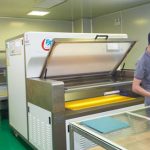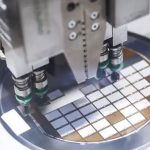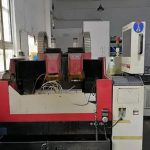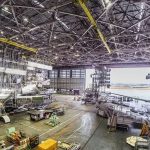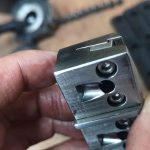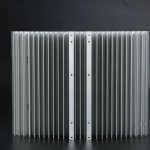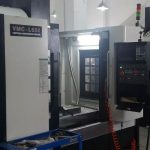The biggest feature of ultra-precision machining is the new achievements in the development of comprehensive application machinery, and the new technologies such as modern electronics, measurement, and computers are the crystallization of mechatronics, which has become one of the important directions for the development of machinery manufacturing. The development of ultra-precision machining relies on ultra-precision machine tools, so the key part of ultra-precision machine tools, ultra-precision servo control and ultra-precision measurement system, as well as the integration of processing and measurement, has received extensive attention and development. In recent years, the development of microelectronic technology and computer technology has become the technical basis for promoting the development of servo control technology to high performance.
With the development of large-scale integrated circuit technology, DSP chips have been developed rapidly, and have been widely used in many fields such as signal processing, communications, radar, remote sensing, voice and image processing, electronic measurement, and automatic control.
In terms of ultra-precision machine tool servo control, in order to achieve sub-micron linear motion accuracy of the machine tool table, the introduction of modern control technology is extremely necessary.
The refined control unit and the realization of continuous feed with tiny program segments have become the salient features of ultra-precision CNC machining, and the interpolation cycle of ultra-precision CNC machining has reached the millisecond level. The large amount of data and high-precision interpolation calculation and control require the computer system to respond to processing instructions at high speed, process and calculate the movement of the servo motor at high speed, and then issue control instructions. DSP’s data throughput capacity is as high as tens of MIPS, and its instruction cycle is as short as tens of nanoseconds, which is very suitable for high-speed data acquisition systems and real-time control systems with large data volumes. It is a good strategy to apply DSP to the development of high-performance ultra-precision CNC systems. In fact, DSP microprocessors have been successfully applied in ultra-precision servo control systems, tool detection compensation and fast servo devices, machine tool protection, etc.
was successfully designed and developed. Its core is the ADSP2181 chip, the interpolation cycle reaches 5ms, the control cycle is 0.5ms, and the programming resolution is 2nm, which already has the basic conditions for actual working conditions.
2 Typical performance of digital signal processor The main application of digital signal processor devices is to quickly implement various digital signal processing algorithms in real time. As a typical DSP device, the functional structure of ADSP2181 is as shown. It has the following typical performances: The piezoelectric ceramic servo device diamond tool error compensation table can complete one multiplication and one addition within one instruction cycle; the program and data space are separated, and instructions and data can be accessed at the same time; there is fast RAM on-chip, usually Simultaneous access in two blocks through an independent data bus; fast interrupt processing and hardware I/O support, which can execute multiple operations in parallel; support pipeline operations, so that operations such as fetching, decoding, and execution can be performed overlapped.
The MAC (multiplication and one addition) time of the ADSP2181 chip has reached 33ns. The number of pins of the chip has reached more than 200. The increase in the number of pins means the increase in structural flexibility, such as external memory expansion and inter-processor Communication, etc. At the same time, the development of DSP chips has greatly reduced the cost, volume, weight, and power consumption of DSP systems.
-generally have good and efficient development tools and assembly language support. Each of the ADSP2100 series provides tools for compiling and connecting to generate executable files, which can be written into the DSP program storage area. DSP also has simulation software, which can simulate program operation, interruption, timing, etc., which has great convenience and is very suitable for the needs of CNC development.
The application of 3DSP in ultra-precision numerical control systems. Numerical control systems can be divided into two types: single processor and multi-processor. The single-processor system takes a single CPU as the control core, and all functions are executed by one CPU in time-sharing. Its software programming is very complicated, and the feed speed of the machine tool is also affected. The typical multi-processor system is a master-slave processor structure. The master CPU completes the foreground control, that is, man-machine interface management, information display and preprocessing; the slave CPU completes the background control, that is, interpolation operation, servo control, and feedback processing. , Responsible for frequent data operations and I/O operations.
The interpolation cycle of the ultra-precision CNC system is very short, the interpolation interval is small, and its control and interpolation calculations are quite frequent, which requires the CNC system to process the position signal feedback of each axis in a very short time. The current interpolation cycle has been Reach the millisecond level. It is difficult for a single-processor numerical control system to achieve such a fast data processing speed, which makes the adoption of a multi-processor system inevitable. DSP devices are an excellent choice for the development of ultra-precision CNC systems due to their powerful data computing capabilities and extremely high operating speeds, and provide the possibility for the adoption of advanced control algorithms in ultra-precision CNC systems.
In fact, DSP devices have a wide range of effective applications in ultra-precision CNC machining servo control, tool monitoring compensation and fast servo, advanced control algorithms, machine tool protection systems, etc.
3.1 Servo control system based on DSP The high-speed DSP microprocessor can realize high-precision position servo control and contour processing control of ultra-precision machine tools, and provide thermal effect and geometric error compensation and control of machine tools and cutting tools. For example, the Faunc15-BCNC system uses the MC68EC030 dual-CPU microprocessor with 33MHz double-precision 64-word length to achieve a 1nm high-speed CNC control system. In terms of high-precision contour processing control, it realizes automatic feed rate control to ensure processing The trajectory is within the allowable error range of the specified trajectory.
In the period, the basic work flow content completed by ADSP2181 is: read the instruction position, calculate and form a new trajectory, query and process external events, and control the motion of the actuator.
Using the super-precision CNC structure of the master-slave multi-processor ADSP2181 has a 16-bit word length, which can complete any instruction in 33ns. Due to the extremely high operating speed, the interpolation period and sampling control period of the system reach 2ms and 0.5ms respectively, which greatly improves the agility and real-time performance of the system. Correspondingly, the control precision in the experimental processing has reached 0.m. Compared with the processing precision of the conventional host control and interpolation control cycle integration, the comprehensive precision index is greatly improved.
3.2 Using DSP to improve the control algorithm. High-speed and high-performance microprocessors, especially the application of digital signal processors (DSP), enable many advanced control strategies and methods, such as adaptive control, learning control, friction control, etc., to be applied In the high-precision servo control system, the control accuracy and speed are greatly improved.
A.Abler proposed the “Direct Damping Control (DDC) algorithm and implemented it with TMS320C30. This algorithm not only makes the positioning and tracking control accuracy of the machine tool reach the sub-micron level, but also effectively reduces the impact of the dynamic vibration and noise of the ultra-precision machine tool on the machine tool. The influence of positioning accuracy. H. Yonezawaetal uses TMS320C30 to realize PID+ friction compensation control algorithm, so that the high-speed positioning accuracy of ultra-precision table reaches 0. YH-I ultra-precision CNC system is based on the powerful data processing capability of ADSP2181, and realizes FuzzrPid compound control The sampling rate of the servo control system reaches 2KHz. In actual operation, the system divides each interpolation cycle into 10 control cycles for servo control, thereby forming a more effective control of the interpolation process and making the curve interpolation more Accurate. The results show that this method greatly improves the accuracy and rapidity of the system’s curve tracking. Compared with the direct PID servo control method of the conventional main processor, the sinusoidal disturbance of the servo system is reduced by about 60%, and the control accuracy is less There is a 70% improvement.
3.3 Application of DSP in Tool Monitoring and Servo In order to compensate the system error in the tool feed movement, the YH~I ultra-precision CNC system adopts self-developed piezoelectric ceramics and ADSP2181 microprocessor constitutes the servo structure to realize the opening The principle structure of the servo control of the loop is: the principle structure diagram Because of the fast calculation capability of ADSP2181, the compensation data of each interpolation control cycle can be quickly and accurately calculated. The tool servo mechanism enables the positioning accuracy of the tool to reach the micron level, and has good and fast dynamics. The new type of CNC machine tool spindle AC motor frequency conversion speed control CNC system He Ping, He Gang 2 Xia Xiuhong 3 (1. Department of Computer Science, Xiangtan University, Hunan Xiangtan 411105 2. Technical Department of Yiyang Rubber Machinery Factory, Yiyang, Hunan 4130003. Xiangtan University Practice Factory, Xiangtan, Hunan 41105) Torque pulsation and motor loss caused by AC sine wave distortion.
In the production of machinery industry, in order to process some mechanical parts with complex shapes and high precision requirements. Everyone makes every effort to tackle key scientific and technological problems, and strives to improve the processing technology and processing equipment. Especially in improving the processing accuracy of the mathematics machine tool, a lot of efforts have been made and better results have been obtained. In order to further improve the machining accuracy, how to achieve the best effect of error avoidance and error compensation in the machine tool numerical control system is still an important way to attract attention. The CNC machine tool spindle speed closed-loop control CNC system introduced in this article uses a sine wave pulse width modulation frequency converter, which can greatly reduce the torque ripple and motor heat loss of the CNC machine tool spindle, thereby improving the machining accuracy of the CNC machine tool. .
1 The structure of the machine tool numerical control system and the spindle speed control as the control center of the numerical control machine tool, the machine tool numerical control system is composed of four basic parts of industrial microcomputer IPC, feed control, auxiliary control and spindle speed control. Dornfeld, etc. establish a neural network-based The real-time system monitors and dynamically compensates for tool wear. In order to improve the real-time response of the system, the system uses a high-speed digital signal processor DSP to complete data processing operations. The system monitors the accuracy of tool wear and is not sensitive to changes in cutting conditions. The correct discrimination rate can reach 95% in the large change range of the conditions, and the dynamic compensation effect is good.
4 Conclusion DSP has been successfully applied in ultra-precision numerical control systems due to its powerful computing power, good I/O operation functions, and extremely high processing speed.
The ultra-precision CNC system on the DSP-based PC platform can allow users to continuously upgrade software and hardware at a small cost, and keep up with the development of CNC technology within a certain period of time, unlike the closed system that will soon fall behind or even disuse. The application of DSP provides a good prospect for the development of ultra-precision CNC servo control systems. From a long-term point of view, to achieve high-speed, accurate, and easy-to-improve tracking servo control, the development of ultra-precision CNC systems with DSP microprocessors is the best choice.
Link to this article:Application of DSP in Ultra-precision CNC System
Reprint Statement: If there are no special instructions, all articles on this site are original. Please indicate the source for reprinting:Alloy Wiki,thanks!^^



